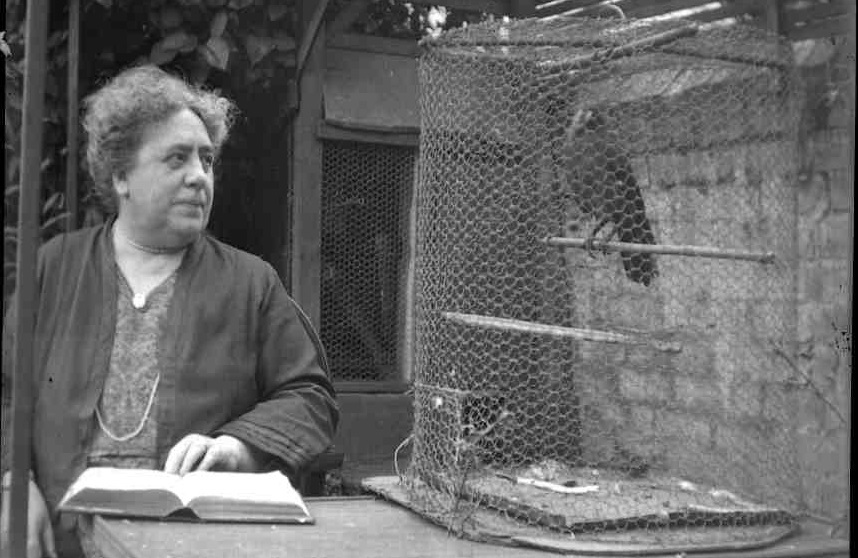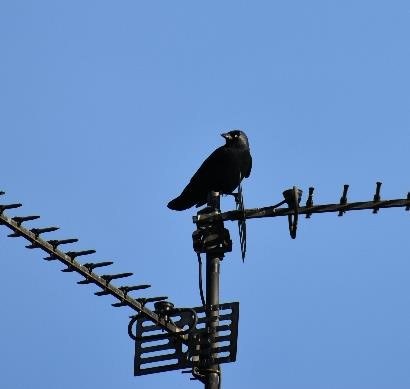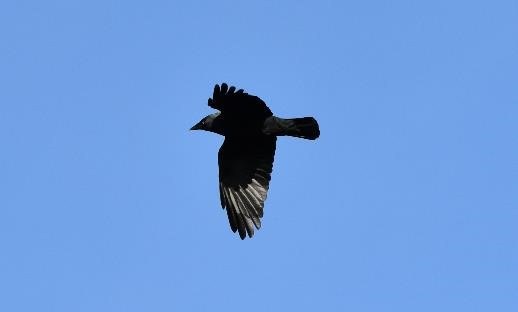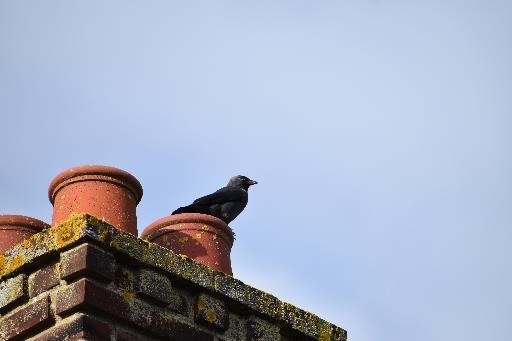Jackdaws (Corvus Monedula)
written by Museum Director Zara Matthews
On 14th February 1924 a jackdaw appeared at Octavia’s bedroom window, Octavia later wrote of a “little black head parting the lace curtains and looking in to the room.” A cage was constructed for ‘Sir Jack Daw’ who became a close companion of Octavia and members of the Society. On the 17th March 1929 the jackdaw escaped for six hours before returning to the garden. ‘Sir Jack Daw’ died on 25th May 1933.
 Octavia sitting her garden with Sir Jack Daw From an original photograph in the Panacea Charitable Trust Archive
Octavia sitting her garden with Sir Jack Daw From an original photograph in the Panacea Charitable Trust Archive
Jackdaws are Corvids, members of the Crow family, and are the smallest type of crow. They are highly intelligent and social birds. Jackdaws can identify individual human faces, which only a few types of birds can do. They adapt well to different environments; thriving in woodlands and adapting to towns and cities too.
Jackdaw feathers are shades of black and dark grey. Adult jackdaws have grey feathers at their neck. As the bird ages the feathers reflect light differently and they can appear to have more grey than black. Male and female birds have the same plumage and are the same size, with a wingspan of about 70cm, and weigh about 220g. They are thought to live about five years.
 ©Z Matthews
©Z Matthews
A group of jackdaws is called a “train” or a “clattering”. The jackdaw call is a distinctive “tchack” and they can often be heard calling to each other.
Jackdaws have a friendly reputation with people, they are known to recognise faces and some studies suggest they can respond to human emotions.
Jackdaw eyes are special. The young birds have blue grey eyes, which change colour as they mature. The iris, circle around the central pupil, changes to brown and then in a mature bird is white. Studies suggest that jackdaws communicate with their eyes, thought to be unique in birds[i].
Jackdaws usually live and move around in groups. They prefer nests in holes that already exist, such as the hole in a tree or a larger nesting box. They make nests in the holes with materials such as twigs, moss, wool and hair.
Their eggs are pale blue or blue green and speckled, and usually lay 4-5 at a time. The eggs hatch at different times, the first chick to hatch has the best chance of survival. Fledglings usually appear in April.
Jackdaws form strong pair bonds and often stay in their pair irrespective of whether they rear chicks or not, although they are not “strictly monogamous”.[ii] They have strong hierarchies within their groups with the social status given to the pair, also same gender pairings are well documented.
Jackdaws roost and feed together, and will show each other sources of food. They mostly east seeds, fruits and small insects, larvae, snails and small frogs, they will also eat road kill and take other birds’ eggs and chicks given the opportunity.
 ©Z Matthews
©Z Matthews
They are resident throughout the UK, except in some mountainous areas in North West Scotland. Jackdaws can usually be seen in parks, gardens, woods and fields. They often roost in trees and will also take advantage of chimney pots, aerials and towers.
Jackdaws are described in poetry and prose, one example is the ‘Jackdaw of Rheims’ by R.H. Barham[iii]; it is possible that Octavia had read or heard of this poem. In this poem the jackdaw becomes a saint.
Jackdaws have also been persecuted, and in the 16th century they were included in laws that allowed them to be killed as vermin. By the 19th century attitudes had changed a little, when their use in eating pests was acknowledged but it was considered important to keep their numbers under control.
The name jackdaw is thought to come from ‘jack’ referring to the call they make or refer to their reputation as a thief (thieves were often known as jack apparently!), and ‘daw’ an old word for smaller members of a species or their call which can also sound like “daw”.
Often connected to folklore, their presence on a roof may suggest a birth or a death. In the Fens a bride seeing a jackdaw on her wedding day was good luck. In some parts of Wales, they were considered sacred.
In ancient history, jackdaws were thought to have once been white, but turned black by the god Apollo after one angered him, or that they went black as a sign of mourning following the Crucifixion. Chaucer refers to them as “Choughs”, which is now used as the term to describe a much rarer corvid with red legs and beak.
There are an estimated 1.55 million pairs in the UK, and are classified as green in terms of the endangered birds list, they are protected under the Wildlife and Countryside Act of 1981.[iv]
Apart from humans, their predators are larger crows especially Ravens, pine martens, weasels, and larger owls. Protected in the UK, jackdaws are hunted in parts of Europe mainly due to the view that they prey on game bird chicks.
Jackdaws are fascinating birds, as Octavia discovered, social and communicative, they tolerate and will, on occasion, befriend humans.
 ©Z Matthews
©Z Matthews
Acknowledgments and further information
https://www.discoverwildlife.com/animal-facts/birds/facts-about-jackdaws/
https://www.rspb.org.uk/birds-and-wildlife/wildlife-guides/bird-a-z/jackdaw/
https://www.countrylife.co.uk/nature/jackdaw-bird-just-loves-people-178185
https://www.wildlifetrusts.org/wildlife-explorer/birds/crows-and-shrikes/jackdaw
https://birdfact.com/birds/jackdaw
https://en.wikipedia.org/wiki/Western_jackdaw
https://www.exeter.ac.uk/news/research/title_913007_en.html
https://phys.org/news/2014-02-non-primates-jackdaws-eyes.html https://bou.org.uk/blog-hooper-secret-sex-lives-jackdaws/
[i] https://phys.org/news/2014-02-non-primates-jackdaws-eyes.html
[ii] https://bou.org.uk/blog-hooper-secret-sex-lives-jackdaws/
[iii] https://www.bartleby.com/246/108.html
[iv] https://www.wildlifetrusts.org/wildlife-explorer/birds/crows-and-shrikes/jackdaw






